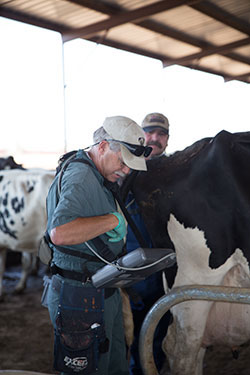 The uterus plays an instrumental role in pregnancy; it is, of course, where the fetus lives. When it comes to dairy cattle, there are many reasons why some cows can't get pregnant, from hormonal and cyclicity issues to timing and management limitations. Reproductive physiologist Milo Wiltbank and others at the University of Wisconsin-Madison believe that uterine size may also play a role.
The uterus plays an instrumental role in pregnancy; it is, of course, where the fetus lives. When it comes to dairy cattle, there are many reasons why some cows can't get pregnant, from hormonal and cyclicity issues to timing and management limitations. Reproductive physiologist Milo Wiltbank and others at the University of Wisconsin-Madison believe that uterine size may also play a role.Their research group evaluated 704 primiparous (first lactation) and multiparous (second lactation or greater) Holstein cows that were synchronized with double ovsynch and bred with A.I. around 83 days in milk. At the last PGF injection, measurements of the uterus were made. Diameter was measured by ultrasound, length was determined by palpation and volume was calculated from those two measurements. Blood samples were also taken to check progesterone levels.
At a 67-day diagnosis, 49.8 percent of the first-lactation cows were confirmed pregnant compared to 39.1 percent of older cows. In general, uterine diameter, length and volume were larger in the multiparous cows than their younger counterparts.
Diameter and volume were found to be smaller in the cows that became pregnant compared to those that did not. A similar trend was found in the first-lactation heifers. Further analysis also showed that, as uterine volume increased, there was a drop in pregnancies per A.I. in both the primiparous and multiparous cows.
Thus, there seems to be a negative relationship between uterine size and fertility, with a larger uterus leading to reduced fertility, particularly in second or greater lactation cows.
"We don't know what causes the difference in uterine size, and we don't know why a larger size in uterus reduces fertility, but we know there's a relationship," Wiltbank said. This was the first study conducted in this area, he explained, and further research will be done.








